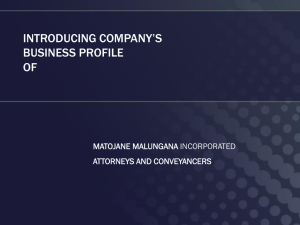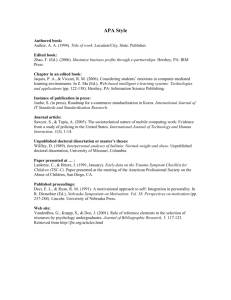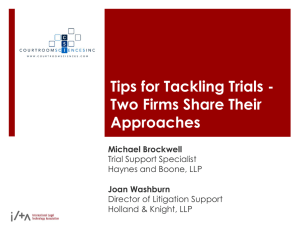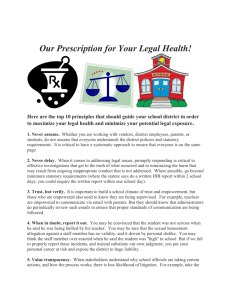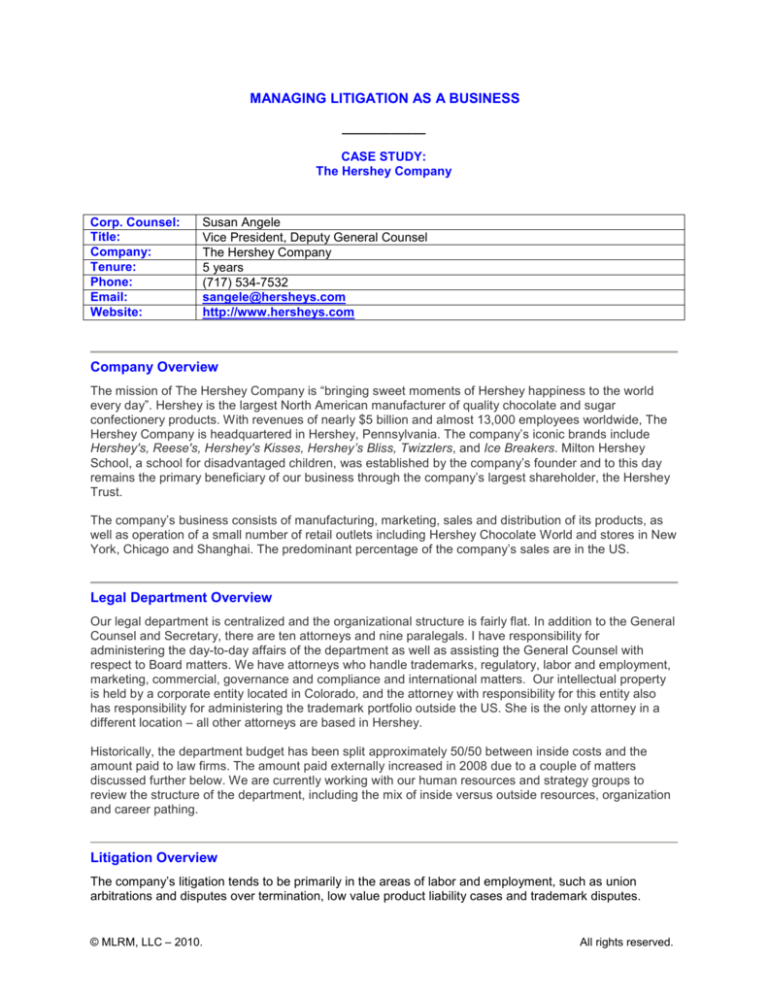
MANAGING LITIGATION AS A BUSINESS
____________
CASE STUDY:
The Hershey Company
Corp. Counsel:
Title:
Company:
Tenure:
Phone:
Email:
Website:
Susan Angele
Vice President, Deputy General Counsel
The Hershey Company
5 years
(717) 534-7532
sangele@hersheys.com
http://www.hersheys.com
Company Overview
The mission of The Hershey Company is “bringing sweet moments of Hershey happiness to the world
every day”. Hershey is the largest North American manufacturer of quality chocolate and sugar
confectionery products. With revenues of nearly $5 billion and almost 13,000 employees worldwide, The
Hershey Company is headquartered in Hershey, Pennsylvania. The company’s iconic brands include
Hershey's, Reese's, Hershey's Kisses, Hershey’s Bliss, Twizzlers, and Ice Breakers. Milton Hershey
School, a school for disadvantaged children, was established by the company’s founder and to this day
remains the primary beneficiary of our business through the company’s largest shareholder, the Hershey
Trust.
The company’s business consists of manufacturing, marketing, sales and distribution of its products, as
well as operation of a small number of retail outlets including Hershey Chocolate World and stores in New
York, Chicago and Shanghai. The predominant percentage of the company’s sales are in the US.
Legal Department Overview
Our legal department is centralized and the organizational structure is fairly flat. In addition to the General
Counsel and Secretary, there are ten attorneys and nine paralegals. I have responsibility for
administering the day-to-day affairs of the department as well as assisting the General Counsel with
respect to Board matters. We have attorneys who handle trademarks, regulatory, labor and employment,
marketing, commercial, governance and compliance and international matters. Our intellectual property
is held by a corporate entity located in Colorado, and the attorney with responsibility for this entity also
has responsibility for administering the trademark portfolio outside the US. She is the only attorney in a
different location – all other attorneys are based in Hershey.
Historically, the department budget has been split approximately 50/50 between inside costs and the
amount paid to law firms. The amount paid externally increased in 2008 due to a couple of matters
discussed further below. We are currently working with our human resources and strategy groups to
review the structure of the department, including the mix of inside versus outside resources, organization
and career pathing.
Litigation Overview
The company’s litigation tends to be primarily in the areas of labor and employment, such as union
arbitrations and disputes over termination, low value product liability cases and trademark disputes.
© MLRM, LLC – 2010.
All rights reserved.
Workers compensation is handled by our risk management department and the attorneys do not get
involved in it unless there is a matter that has other potential legal implications. Historically, there have
been approximately 30-40 cases pending at any one time, with one or two expected to incur legal fees in
excess of $100,000. These higher value cases tend to be non-repetitive. Historically our outside counsel
spend has been at or below the median for our peer group.
In 2008, the company has been faced with a number of high-cost matters that have increased our outside
spend beyond historical levels. These matters are expected to continue at least through 2009.
Approach to Litigation Management
The first and most effective approach is that the company culture and the close relationship between
lawyers and the business help to avoid litigation. Our attorneys work very closely with their business
partners and so are able to help guide their actions up front in a way that manages risk and expectations.
The company has a strong ethics and compliance program with absolute commitment from the executive
suite, a robust system for monitoring employee engagement as well as airing and resolving employee
complaints and an approach to consumer marketing that begins with a cross-functional review board to
ensure truth in advertising and continues with a responsive system for receiving and addressing
consumer complaints. When we are sued, the attorney’s knowledge of the business enables him/her to
very quickly assess the potential liability and understand what other potential copycat litigation might be
in the wings if this case were to settle.
The in-house attorney with responsibility for the substantive area manages litigation in their area. This
attorney selects outside counsel and is responsible for managing the cost and progress of the case. We
have staff meetings every other week including all of the attorneys in the department and review pending
matters at that meeting. In addition, we have recently designated one attorney to coordinate e-discovery
matters for the department – her role is to engage third-party providers and establish policies so that
there is a consistent company approach, but each attorney remains responsible for implementing these
policies on their own matters. Our primary means of cost control is through selection of outside counsel
and close monitoring of the cases.
Litigation Management – Marked Achievement
This past year, we have a renewed focus on cost control due to the facts that we coincidentally have a
higher than usual number of large matters pending (some in which we are defending, some in which we
are plaintiff) and we are at the same time seeing an increase in cost by orders of magnitude due to the
explosion in electronically stored information. This has led us to develop a number of processes. While I
can’t call them an achievement yet as they are still a work in progress, we are hopeful. This is what we
are doing:
1. Visibility of total cost. Each of our attorneys reviews bills as they come in, however there has
been no review of the total cost of a case from beginning to end. We are now beginning to track
this, to use for purposes of the attorneys’ ability to understand total cost better, compare cost
across comparable cases, help budget and educate clients.
2. Organizational incentives. We have struggled with what kind of accountability to require with
respect to litigation cost, and historically have held the General Counsel and I accountable for
total cost but have not included cost as a factor in performance evaluations for any other
attorneys. This year, each attorney who has a significant budget has a specific performance goal
related to cost control.
3. Strategic sourcing. Our strategic sourcing group is working with us on a project to reduce the
number of firms that we use and we will expect our preferred firms to be highly flexible and
innovative in their approach to fees. This also gives us the ability to put teeth into our expectation
© MLRM, LLC – 2010.
All rights reserved.
that firms value and encourage diversity.
4. Unbundling of non-legal costs. We are in the process of reviewing rfp responses with respect to
an e-discovery vendor, and are looking for other areas where it makes sense for us to have a
direct relationship with vendors, e.g., for copying materials.
5. Unbundling of legal costs. We are also in the process of establishing relationships for document
review and are looking at other potential solutions (e.g., we may use a high-priced firm for most of
a litigation but use local counsel for certain motions, depositions, etc.)
6. Negotiating with firms. We are using fixed fees for certain matters (EEO charges, arbitrations,
trademark cease and desist), use guidelines that outline what we will and won’t pay for and
receive discounted rates from firms we do a large business with.
Litigation Management – Lessons Learned / Recommendations
It sounds obvious, but the largest lesson learned is that law firms are very open to fee discussions and
you can get a lot just by asking. After one of our law firms included a 4.5% hourly rate increase in its
January bill, we discussed it with them and found that not only did they immediately waive the fee
increase but they increased our percentage discount and are putting together a proposal for alternative
fee arrangements for us.
Litigation Management – Biggest Current Challenge
Our most significant expenses are now and historically have tended to be for the large, unusual cases.
Cost saving practices and processes tend to be easier to identify and implement where there is a steady
stream of similar types of cases, and we have made great progress in these over the years. We are
hopeful that the measures identified above will help with the larger cases as well as those that are more
routine.
Litigation Management – Target Areas for Improvement
Performance evaluation and feedback – Right now we do not have a formal evaluation process for
outside counsel. This will be developed as part of the work we are doing with the strategic sourcing
group.
Unbundling and outsourcing litigation support services for cost containment – We are working toward this
as noted above.
Effective management of discovery/e-discovery process – This is a significant project for us to develop
processes and relationships with vendors in this area.
© MLRM, LLC – 2010.
All rights reserved.


